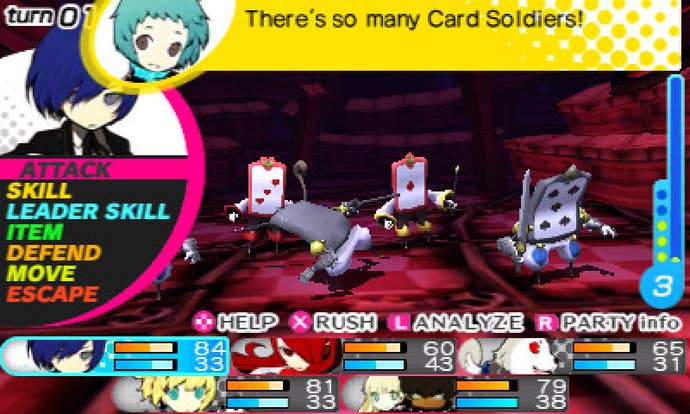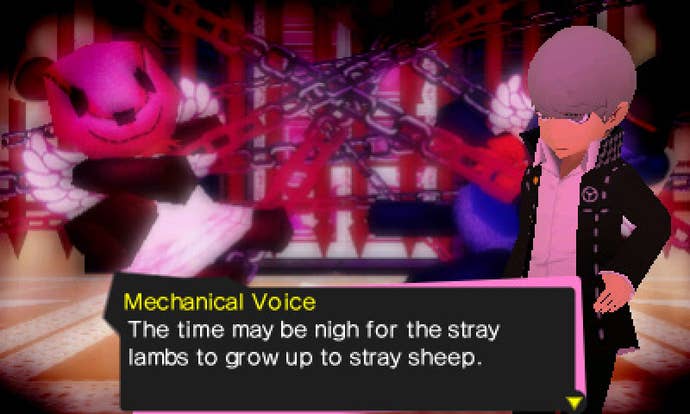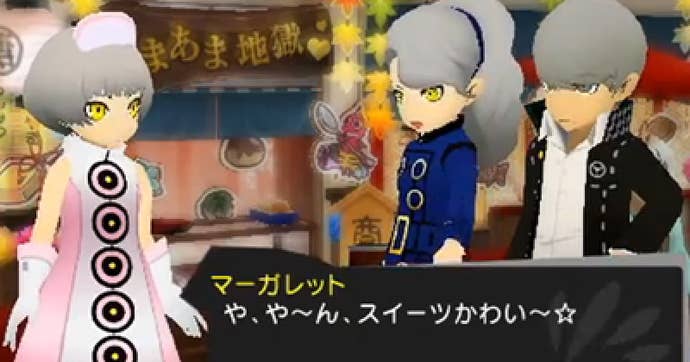How You Helped Design Persona Q
Artist Shigenori Soejima talks about the role fans had in creating Atlus' upcoming dungeon crawler.
This article first appeared on USgamer, a partner publication of VG247. Some content, such as this article, has been migrated to VG247 for posterity after USgamer's closure - but it has not been edited or further vetted by the VG247 team.
Having been a designer and illustrator in a former life, I don't envy Shigenori Soejima the role he was assigned for Persona Q, Atlus' upcoming 3DS role-playing game. The game sits at the intersection of three fan-favorites: Persona 3, Persona 4, and Etrian Odyssey. And somehow, visually, it has to make them all work together.
Design for the Persona series must be difficult enough, given that its roots stretch back more than 25 years to the 8-bit Megami Tensei games. Through a couple dozen different sequels and spinoffs, the MegaTen franchise has evolved considerably, incorporating an ever-changing visual style while making use of a consistent set of creatures and mythological figures. Like Capcom's infamous Morrigan sprite that continued to appear in fighting games well past its sell-by date, elements of the MegaTen games sometimes seem ill-fitting and out of place. Add the aesthetics and world view of a completely different series to that already complicated mix and there's no reason Persona Q should have collapsed in on itself as a muddled mishmash of visual incoherence.

And yet, it works, deftly taking the elements of Persona and shrinking them into a colorful and decidedly groovy take on the universe, all run through an Etrian Odyssey filter that renders the cast as squat, chubby little cartoon versions of themselves.
"This was my first time working in the super-deformed art style," Soejima admits. "It was a good experience, but very different. I'm not used to making characters look so cute! But because there's so many different characters, I had fun working on all of them, trying to make them look as adorable as possible."
It's an odd collision of styles. The series' iconic demons largely retain their original visual style even as the playable cast takes on a childish look, but the disparity in appearance only helps enhance the uncanniness of Persona's universe. Bizarre and outlandish demons fit right in with the fluid and colorful graphics — the game's earliest encounters involve otherworldly demons — while more "realistic" humanoids like Angel and Nekomata feel much further removed from the heroes, enhancing the impression that these adventurous high schoolers are playing with forces from another reality.
"There are two big reasons for the super-deformed art style" Soejima says. "One being that, because this is a crossover with Etrian, which has always had that style, we wanted to keep that iconic look so that when people saw it they'd know, 'Oh, this is similar to Etrian Odyssey.' If it were in the regular-looking Persona style, especially on 3DS, people might be confused and wonder, 'Is this a new Persona game, a new Etrian title?'

"Secondly, on the 3DS, the screen is much smaller. My usual type of character designs... trying to squeeze them onto a tiny screen just wouldn't look good. In order for my characters to shine, basically we had to scale them down."
The marriage of the Persona and Etrian Odyssey series goes far beyond mere visuals, though; Persona Q pulls the cast of P3 and P4, along with their standard repertoire of skills and summons, into a dungeon crawler that works very much like the Etrian games. You map your route through the labyrinth, traveling in a first-person grid-based viewpoint, while an indicator in the corner warns of you of impending random encounters. You even have to contend with powerful monsters that visibly patrol the dungeon, and just as in Etrian Odyssey, they're called F.O.E.s.
Despite the framework, though, it's all quite faithful to Persona. Not just in the characters and skills, but also in its presentation. The first dungeon you enter has a surreal Alice in Wonderland motif, with the doors that divide the dungeon consisting of piano keys that draw apart and clocks dotting the walls. It's far weirder than Etrian's staid high-fantasy-esque stylings, and frankly appears far more technically proficient as well. The amount of plot and exposition is far more in keeping with the talkative Persona standard than the terse Etrian style; even last year's anime-flavored Etrian Odyssey Untold felt far less chatty than Persona.
Soejima says Untold wasn't actually the trial run for Persona Q that it might seem to be, though. "Etrian Odyssey Untold was just a coincidence. The director of Persona Q is the same as the recent Etrian games. Everything he learned there he brought into this game. But otherwise, the staff that makes the Etrian series and the staff that makes the Persona series — including Persona Q — are very different. And the fans are very different as well. "

Soejima's main task with Persona Q was to reconcile those two different styles of character design, rendering the cast of lanky teenagers he created for P3 and P4 in a format that fits Etrian's trademark cute-but-deadly approach.
"Obviously, these interpretations of the characters are very different, because making something from scratch... you go through a complicated process," he muses. "Trying out what works, seeing it as a silhouette — that's especially important for 'realistic' characters, because you have to be able to tell them apart at a glance.
"In this game, because they're smaller, I'd take my original character designs, the taller ones, and decide which details to keep and which to remove. When you make such small characters, there are a lot of things that get lost. I had to do a lot of back-and-forth comparisons... look at my original, look at the redesign, and make sure that the new appearance translates well to the new look. Hopefully, I was able to reduce the characters to their essence."
On the other hand, Persona Q has allowed him to rethink and revise some of his older creations — a chance to refine nagging flaws and shortcomings.
"It's been 10 years since I designed some of these characters for Persona 3, and when I look at those old illustrations, I think, 'Ah, I wish I had done this differently, or done that a little better.' That happens for any artist, I think."

But perhaps the biggest changes, Soejima says, have come about as a result of fan feedback. The Persona games' loyal following has largely revolved around the series' characters, and to a certain degree fans have taken control of the cast and affected how the creators see them as well.
"In the 10 years since P3 debuted, fans have responded to these characters," says Soejima. "There was the movie, there was Persona 3 FES, and Persona 3 Portable... during that time, there's been so much feedback, and so much has been done with those characters beyond the original game in all these different mediums. I took those things to heart as I was working on Persona Q. Things have evolved thanks to the fans who love the characters so much.
"Elizabeth is a great example of this. In the original P3, she was seen as the strongest character in the game, and that was pretty much it. You had a few events with her, but that was really all you saw of her. Over the years, though, fans have projected more personality on to her, and because of that many of the things fans saw in her were worked into Persona Q. So she matured because of the fans.

"You may have seen images of Elizabeth in previews wearing a pink nurse outfit. That was not the type of character I had in mind when I first created her! She was supposed to be a very sophisticated, more otherworldly being from the Velvet Room, and there really wasn't much interaction with the protagonist. Whereas now she's become more familiar, and has a lot more facial expressions. The fact that she'd be willing to wear something like that shows how she's evolved from the beginning to now.
"I also think the two protagonists — the P3 protagonist and the P4 protagonist — may have evolved even more than she has. Originally in the games, they were meant to be in the background so the player could 'become' that character. After the game was released, and the movie, and the anime... these characters have personalities now. A lot of that comes from the way players saw the protagonists as they were playing."
Ultimately, though, Soejima was only involved in Persona Q at the visual level. He has much bigger fish to fry at the moment, though he remains coy about the details. "Persona 5, compared to the other titles that have been announced..," he muses, "I'm involved in it much more than just the character designs. But I can't really talk about that now."








